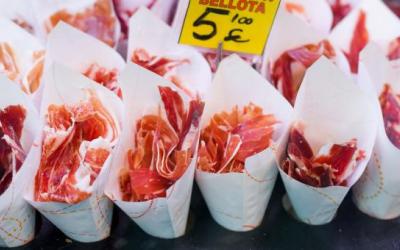Exports of livestock products last year exceeded 1 million tons

The expert recalled that at the turn of 2018-2019, with intensive growth in production, we reached 100% self-sufficiency in pork. However, investments made in business up to 2019 inclusive , which were stimulated by preferential loans, led to a further increase in production at a level of 5% to 8% per year. “Thus, although we reached 100% self-sufficiency several years ago, pork production continues to grow,” Kovalev emphasized. Therefore, the main challenge for the industry now is the risk of market oversaturation, as well as a possible decrease in wholesale prices, aggravated by inflation, an increase in production costs and a decrease in margins and profitability.
In 2023, the increase in industrial pork production was 6.5% compared to 2022, however, due to high demand, prices did not drop - on average for the year they were 6% higher than in 2022 - at the level of 2021. th. The fact is that last year, in addition to an increase in demand, presented the pig farming sector with many surprises, in particular an increase in household incomes, as well as a significant breakthrough in exports. “After a 10-15% drop in shipments to foreign markets in 2022, we increased this figure by 38% at the end of last year, selling a total of 240 thousand tons of pig products to foreign markets,” Kovalev noted. EXPORT items included live pigs, MEAT , bacon, and offal. “In total, exports of livestock products from RUSSIA, including live cattle and by-products, exceeded 1 million tons at the end of last year, with a total value of more than $2 billion,” the HEAD of the NSS cited the data. The main buyer of Russian pig products is Belarus , and Vietnam is also a major importer .
Meat consumption over the past eight years in Russia has increased by 13%, mainly due to the increase in pork consumption - within this 13%, the share of this type of meat is 33%. The reason, Kovalev explained, is that prices for it are growing more slowly than for other types of meat: for pork over the past eight years they have increased by 25%, while overall food inflation over this period was 72%.
By the end of this year, the NSS expects an increase in pork production of 6-7%. In the following years, the rate of increase in production will slow down, although the figure will still continue to grow - by the end of 2026, industrial enterprises will add another 600 thousand tons of pork in slaughter weight to the current volumes, predicts Kovalev. These volumes will be distributed to domestic consumption, which is expected to grow slightly. In addition, production in the private household plot sector will continue to decline. The remaining volumes will be exported. With the opening of CHINA last year, our enterprises have new opportunities to increase shipments. The first batches are already leaving there, Kovalev shared. He noted that in this market he will have to compete with strong enterprises from CANADA, the usa , and Brazil. Nowadays , offal products that are traditional for the country - legs, tails, ears, snouts, tracheas - go mainly to China from Russia. But the NSS expects that in the future the structure of exports will change and at least 50% will come from various cuts of meat, and 50% from by-products.
Read together with it:
- Парагвай: Экспорт субпродуктов является растущей отраслью и уже достиг 95,4 млн долларов СШАЭкспорт говяжьих субпродуктов в этом году значительно вырос. К концу августа выручка составила 95,4 млн долларов США по сравнению с 54,6 млн долларов США на тот же конец прошлого года. По данным SENACSA, в конце августа этого года было экспортировано 51 миллион килограммов мяса по сравнению с 33,7 миллиона килограммов на конец того же месяца прошлого года. Экспорт субпродуктов увеличился на 51,3%....
- Новые горизонты сотрудничества: Россия и Аргентина обсуждают совместный доступ на рынки продукции животного происхожденияОдной из ключевых тем конференции стал контроль за производством ветеринарных препаратов в Аргентине. Аргентинская сторона представила свою систему контроля, включающую Управление ветеринарных продуктов и Управление лабораторий животных. Эти организации обеспечивают высокие стандарты безопасности, так как каждая производственная единица подвергается проверкам каждые 3-5 лет и зарегистрирована в ин...
- Indilight held a culinary masterclass with Silvena Rowe, promoting turkey as a healthy food.Silvena Rowe demonstrated original turkey cooking techniques, emphasizing its nutritional value. Participants prepared crispy turkey schnitzel with an almond-herb crust and turkey with turmeric and lime. The masterclass also emphasized a scientific approach to nutrition and promoted turkey as an ideal food for a healthy lifestyle. During the event, guests received unique gifts from the Louis Quart...
- Министерство сельского хозяйства США представило план по снижению цен на говядинуПоголовье скота в стране находится на самом низком уровне за последние 75 лет, в то время как спрос на говядину вырос на 9% за последнее десятилетие. Поскольку увеличение поголовья скота в стране требует времени, Министерство сельского хозяйства США (USDA) уже сейчас инвестирует средства, чтобы сделать эти рынки менее волатильными для скотоводов в долгосрочной перспективе и более доступными для по...
- С января по июль экспорт свинины из ЕС вырос на 1,6%На втором месте оказались Нидерланды с объёмом экспорта в 392 000 тонн. Дания экспортировала свинину в третьи страны с объёмом в 308 000 тонн, что примерно на 13% меньше, чем в предыдущем году. Германия экспортировала 180 000 тонн, что на 18% меньше, чем годом ранее. Это было обусловлено, главным образом, дополнительными ограничениями на экспорт, вызванными вспышкой ящура в начале года. Помимо зап...





























































